NURS3002 Assignment 3: Analyzing Nursing Practice Through Standards
VerifiedAdded on 2021/04/17
|11
|5202
|51
Report
AI Summary
This report analyzes a nursing practice assignment, focusing on the application of nursing standards in the care of a patient undergoing a total hip replacement (THR). The assignment, based on a clinical placement, emphasizes critical thinking, patient assessment, and the development of a therapeutic relationship. The report details the nurse's role in assessing the patient, Mrs. White, who had undergone a THR, including her medical history, physical and psychosocial assessments. It highlights the importance of adhering to legal and ethical guidelines, such as the Nursing and Midwifery Board of Australia standards and relevant legislation. The report further explores the nurse's engagement in building a therapeutic relationship with the patient, demonstrating empathy, culturally competent communication, and patient participation in care decisions. It also covers the provision of safe, appropriate, and responsive quality nursing practice. The assignment references relevant literature to support the application of nursing standards and emphasizes the nurse's responsibility in ensuring patient safety and promoting optimal patient outcomes. The nurse successfully managed the patient's care, demonstrating critical thinking and adherence to professional standards. This assignment offers valuable insights into the practical application of nursing principles in a real-world clinical setting.
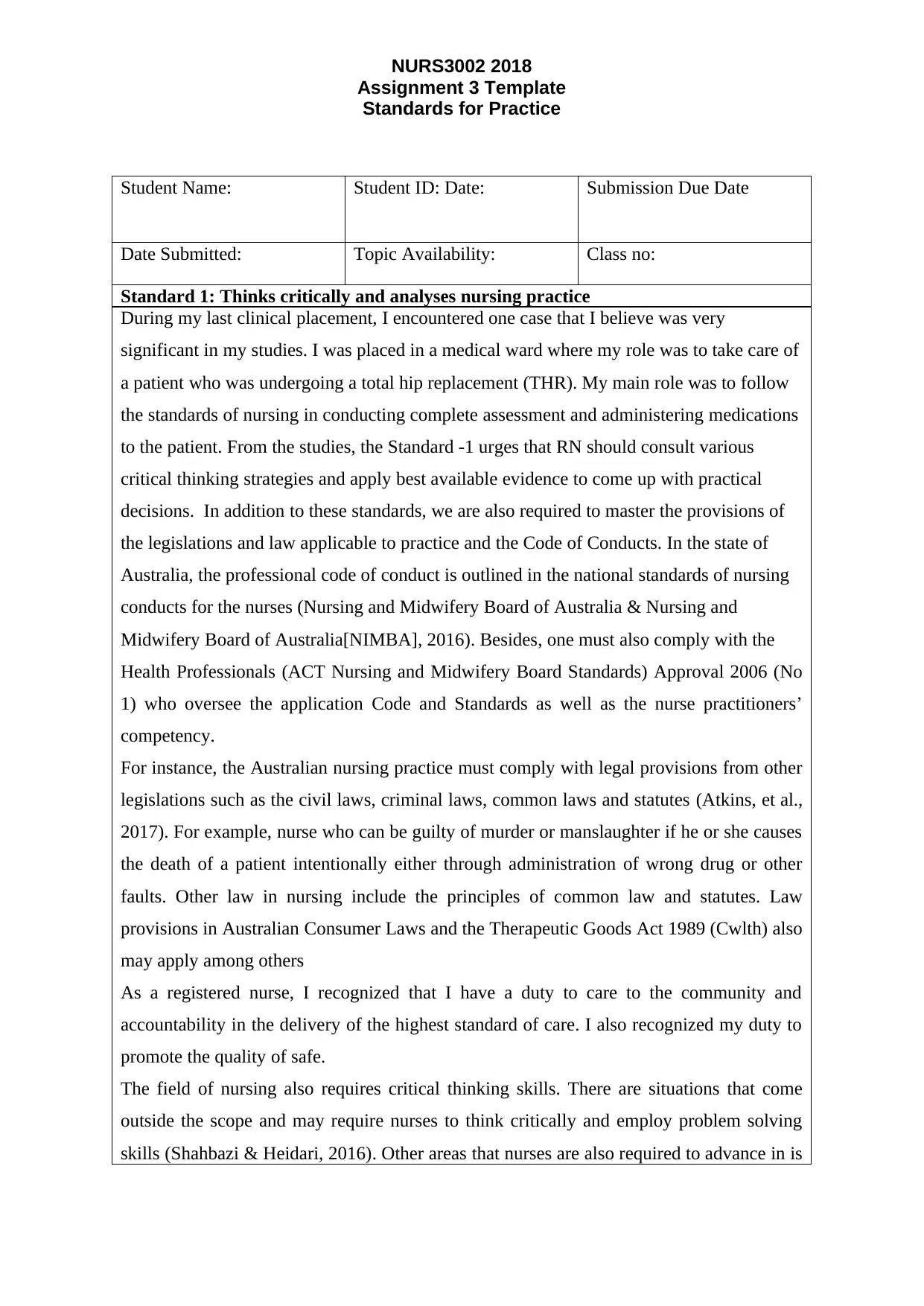
NURS3002 2018
Assignment 3 Template
Standards for Practice
Student Name: Student ID: Date: Submission Due Date
Date Submitted: Topic Availability: Class no:
Standard 1: Thinks critically and analyses nursing practice
During my last clinical placement, I encountered one case that I believe was very
significant in my studies. I was placed in a medical ward where my role was to take care of
a patient who was undergoing a total hip replacement (THR). My main role was to follow
the standards of nursing in conducting complete assessment and administering medications
to the patient. From the studies, the Standard -1 urges that RN should consult various
critical thinking strategies and apply best available evidence to come up with practical
decisions. In addition to these standards, we are also required to master the provisions of
the legislations and law applicable to practice and the Code of Conducts. In the state of
Australia, the professional code of conduct is outlined in the national standards of nursing
conducts for the nurses (Nursing and Midwifery Board of Australia & Nursing and
Midwifery Board of Australia[NIMBA], 2016). Besides, one must also comply with the
Health Professionals (ACT Nursing and Midwifery Board Standards) Approval 2006 (No
1) who oversee the application Code and Standards as well as the nurse practitioners’
competency.
For instance, the Australian nursing practice must comply with legal provisions from other
legislations such as the civil laws, criminal laws, common laws and statutes (Atkins, et al.,
2017). For example, nurse who can be guilty of murder or manslaughter if he or she causes
the death of a patient intentionally either through administration of wrong drug or other
faults. Other law in nursing include the principles of common law and statutes. Law
provisions in Australian Consumer Laws and the Therapeutic Goods Act 1989 (Cwlth) also
may apply among others
As a registered nurse, I recognized that I have a duty to care to the community and
accountability in the delivery of the highest standard of care. I also recognized my duty to
promote the quality of safe.
The field of nursing also requires critical thinking skills. There are situations that come
outside the scope and may require nurses to think critically and employ problem solving
skills (Shahbazi & Heidari, 2016). Other areas that nurses are also required to advance in is
Assignment 3 Template
Standards for Practice
Student Name: Student ID: Date: Submission Due Date
Date Submitted: Topic Availability: Class no:
Standard 1: Thinks critically and analyses nursing practice
During my last clinical placement, I encountered one case that I believe was very
significant in my studies. I was placed in a medical ward where my role was to take care of
a patient who was undergoing a total hip replacement (THR). My main role was to follow
the standards of nursing in conducting complete assessment and administering medications
to the patient. From the studies, the Standard -1 urges that RN should consult various
critical thinking strategies and apply best available evidence to come up with practical
decisions. In addition to these standards, we are also required to master the provisions of
the legislations and law applicable to practice and the Code of Conducts. In the state of
Australia, the professional code of conduct is outlined in the national standards of nursing
conducts for the nurses (Nursing and Midwifery Board of Australia & Nursing and
Midwifery Board of Australia[NIMBA], 2016). Besides, one must also comply with the
Health Professionals (ACT Nursing and Midwifery Board Standards) Approval 2006 (No
1) who oversee the application Code and Standards as well as the nurse practitioners’
competency.
For instance, the Australian nursing practice must comply with legal provisions from other
legislations such as the civil laws, criminal laws, common laws and statutes (Atkins, et al.,
2017). For example, nurse who can be guilty of murder or manslaughter if he or she causes
the death of a patient intentionally either through administration of wrong drug or other
faults. Other law in nursing include the principles of common law and statutes. Law
provisions in Australian Consumer Laws and the Therapeutic Goods Act 1989 (Cwlth) also
may apply among others
As a registered nurse, I recognized that I have a duty to care to the community and
accountability in the delivery of the highest standard of care. I also recognized my duty to
promote the quality of safe.
The field of nursing also requires critical thinking skills. There are situations that come
outside the scope and may require nurses to think critically and employ problem solving
skills (Shahbazi & Heidari, 2016). Other areas that nurses are also required to advance in is
Paraphrase This Document
Need a fresh take? Get an instant paraphrase of this document with our AI Paraphraser
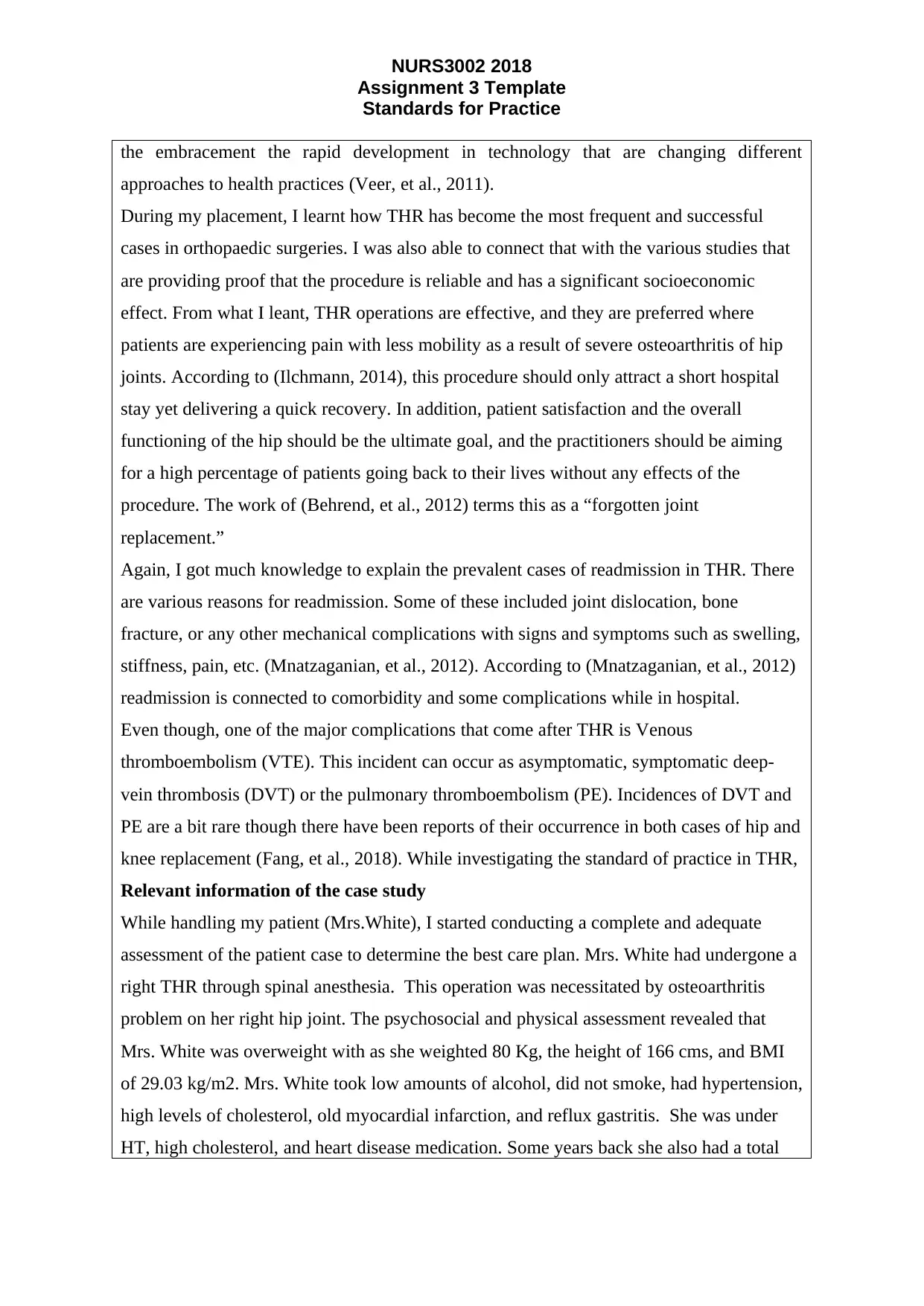
NURS3002 2018
Assignment 3 Template
Standards for Practice
the embracement the rapid development in technology that are changing different
approaches to health practices (Veer, et al., 2011).
During my placement, I learnt how THR has become the most frequent and successful
cases in orthopaedic surgeries. I was also able to connect that with the various studies that
are providing proof that the procedure is reliable and has a significant socioeconomic
effect. From what I leant, THR operations are effective, and they are preferred where
patients are experiencing pain with less mobility as a result of severe osteoarthritis of hip
joints. According to (Ilchmann, 2014), this procedure should only attract a short hospital
stay yet delivering a quick recovery. In addition, patient satisfaction and the overall
functioning of the hip should be the ultimate goal, and the practitioners should be aiming
for a high percentage of patients going back to their lives without any effects of the
procedure. The work of (Behrend, et al., 2012) terms this as a “forgotten joint
replacement.”
Again, I got much knowledge to explain the prevalent cases of readmission in THR. There
are various reasons for readmission. Some of these included joint dislocation, bone
fracture, or any other mechanical complications with signs and symptoms such as swelling,
stiffness, pain, etc. (Mnatzaganian, et al., 2012). According to (Mnatzaganian, et al., 2012)
readmission is connected to comorbidity and some complications while in hospital.
Even though, one of the major complications that come after THR is Venous
thromboembolism (VTE). This incident can occur as asymptomatic, symptomatic deep-
vein thrombosis (DVT) or the pulmonary thromboembolism (PE). Incidences of DVT and
PE are a bit rare though there have been reports of their occurrence in both cases of hip and
knee replacement (Fang, et al., 2018). While investigating the standard of practice in THR,
Relevant information of the case study
While handling my patient (Mrs.White), I started conducting a complete and adequate
assessment of the patient case to determine the best care plan. Mrs. White had undergone a
right THR through spinal anesthesia. This operation was necessitated by osteoarthritis
problem on her right hip joint. The psychosocial and physical assessment revealed that
Mrs. White was overweight with as she weighted 80 Kg, the height of 166 cms, and BMI
of 29.03 kg/m2. Mrs. White took low amounts of alcohol, did not smoke, had hypertension,
high levels of cholesterol, old myocardial infarction, and reflux gastritis. She was under
HT, high cholesterol, and heart disease medication. Some years back she also had a total
Assignment 3 Template
Standards for Practice
the embracement the rapid development in technology that are changing different
approaches to health practices (Veer, et al., 2011).
During my placement, I learnt how THR has become the most frequent and successful
cases in orthopaedic surgeries. I was also able to connect that with the various studies that
are providing proof that the procedure is reliable and has a significant socioeconomic
effect. From what I leant, THR operations are effective, and they are preferred where
patients are experiencing pain with less mobility as a result of severe osteoarthritis of hip
joints. According to (Ilchmann, 2014), this procedure should only attract a short hospital
stay yet delivering a quick recovery. In addition, patient satisfaction and the overall
functioning of the hip should be the ultimate goal, and the practitioners should be aiming
for a high percentage of patients going back to their lives without any effects of the
procedure. The work of (Behrend, et al., 2012) terms this as a “forgotten joint
replacement.”
Again, I got much knowledge to explain the prevalent cases of readmission in THR. There
are various reasons for readmission. Some of these included joint dislocation, bone
fracture, or any other mechanical complications with signs and symptoms such as swelling,
stiffness, pain, etc. (Mnatzaganian, et al., 2012). According to (Mnatzaganian, et al., 2012)
readmission is connected to comorbidity and some complications while in hospital.
Even though, one of the major complications that come after THR is Venous
thromboembolism (VTE). This incident can occur as asymptomatic, symptomatic deep-
vein thrombosis (DVT) or the pulmonary thromboembolism (PE). Incidences of DVT and
PE are a bit rare though there have been reports of their occurrence in both cases of hip and
knee replacement (Fang, et al., 2018). While investigating the standard of practice in THR,
Relevant information of the case study
While handling my patient (Mrs.White), I started conducting a complete and adequate
assessment of the patient case to determine the best care plan. Mrs. White had undergone a
right THR through spinal anesthesia. This operation was necessitated by osteoarthritis
problem on her right hip joint. The psychosocial and physical assessment revealed that
Mrs. White was overweight with as she weighted 80 Kg, the height of 166 cms, and BMI
of 29.03 kg/m2. Mrs. White took low amounts of alcohol, did not smoke, had hypertension,
high levels of cholesterol, old myocardial infarction, and reflux gastritis. She was under
HT, high cholesterol, and heart disease medication. Some years back she also had a total
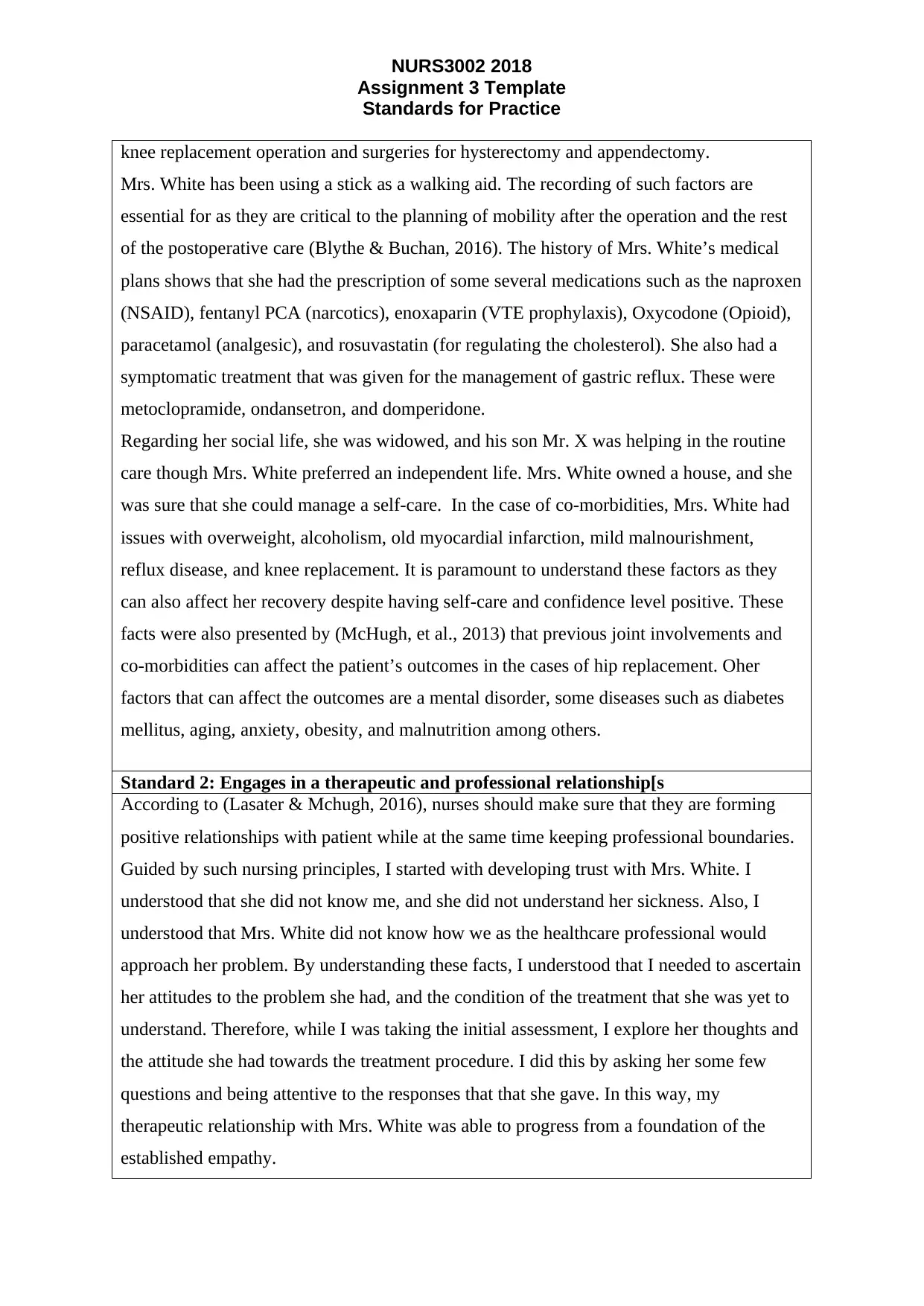
NURS3002 2018
Assignment 3 Template
Standards for Practice
knee replacement operation and surgeries for hysterectomy and appendectomy.
Mrs. White has been using a stick as a walking aid. The recording of such factors are
essential for as they are critical to the planning of mobility after the operation and the rest
of the postoperative care (Blythe & Buchan, 2016). The history of Mrs. White’s medical
plans shows that she had the prescription of some several medications such as the naproxen
(NSAID), fentanyl PCA (narcotics), enoxaparin (VTE prophylaxis), Oxycodone (Opioid),
paracetamol (analgesic), and rosuvastatin (for regulating the cholesterol). She also had a
symptomatic treatment that was given for the management of gastric reflux. These were
metoclopramide, ondansetron, and domperidone.
Regarding her social life, she was widowed, and his son Mr. X was helping in the routine
care though Mrs. White preferred an independent life. Mrs. White owned a house, and she
was sure that she could manage a self-care. In the case of co-morbidities, Mrs. White had
issues with overweight, alcoholism, old myocardial infarction, mild malnourishment,
reflux disease, and knee replacement. It is paramount to understand these factors as they
can also affect her recovery despite having self-care and confidence level positive. These
facts were also presented by (McHugh, et al., 2013) that previous joint involvements and
co-morbidities can affect the patient’s outcomes in the cases of hip replacement. Oher
factors that can affect the outcomes are a mental disorder, some diseases such as diabetes
mellitus, aging, anxiety, obesity, and malnutrition among others.
Standard 2: Engages in a therapeutic and professional relationship[s
According to (Lasater & Mchugh, 2016), nurses should make sure that they are forming
positive relationships with patient while at the same time keeping professional boundaries.
Guided by such nursing principles, I started with developing trust with Mrs. White. I
understood that she did not know me, and she did not understand her sickness. Also, I
understood that Mrs. White did not know how we as the healthcare professional would
approach her problem. By understanding these facts, I understood that I needed to ascertain
her attitudes to the problem she had, and the condition of the treatment that she was yet to
understand. Therefore, while I was taking the initial assessment, I explore her thoughts and
the attitude she had towards the treatment procedure. I did this by asking her some few
questions and being attentive to the responses that that she gave. In this way, my
therapeutic relationship with Mrs. White was able to progress from a foundation of the
established empathy.
Assignment 3 Template
Standards for Practice
knee replacement operation and surgeries for hysterectomy and appendectomy.
Mrs. White has been using a stick as a walking aid. The recording of such factors are
essential for as they are critical to the planning of mobility after the operation and the rest
of the postoperative care (Blythe & Buchan, 2016). The history of Mrs. White’s medical
plans shows that she had the prescription of some several medications such as the naproxen
(NSAID), fentanyl PCA (narcotics), enoxaparin (VTE prophylaxis), Oxycodone (Opioid),
paracetamol (analgesic), and rosuvastatin (for regulating the cholesterol). She also had a
symptomatic treatment that was given for the management of gastric reflux. These were
metoclopramide, ondansetron, and domperidone.
Regarding her social life, she was widowed, and his son Mr. X was helping in the routine
care though Mrs. White preferred an independent life. Mrs. White owned a house, and she
was sure that she could manage a self-care. In the case of co-morbidities, Mrs. White had
issues with overweight, alcoholism, old myocardial infarction, mild malnourishment,
reflux disease, and knee replacement. It is paramount to understand these factors as they
can also affect her recovery despite having self-care and confidence level positive. These
facts were also presented by (McHugh, et al., 2013) that previous joint involvements and
co-morbidities can affect the patient’s outcomes in the cases of hip replacement. Oher
factors that can affect the outcomes are a mental disorder, some diseases such as diabetes
mellitus, aging, anxiety, obesity, and malnutrition among others.
Standard 2: Engages in a therapeutic and professional relationship[s
According to (Lasater & Mchugh, 2016), nurses should make sure that they are forming
positive relationships with patient while at the same time keeping professional boundaries.
Guided by such nursing principles, I started with developing trust with Mrs. White. I
understood that she did not know me, and she did not understand her sickness. Also, I
understood that Mrs. White did not know how we as the healthcare professional would
approach her problem. By understanding these facts, I understood that I needed to ascertain
her attitudes to the problem she had, and the condition of the treatment that she was yet to
understand. Therefore, while I was taking the initial assessment, I explore her thoughts and
the attitude she had towards the treatment procedure. I did this by asking her some few
questions and being attentive to the responses that that she gave. In this way, my
therapeutic relationship with Mrs. White was able to progress from a foundation of the
established empathy.
⊘ This is a preview!⊘
Do you want full access?
Subscribe today to unlock all pages.

Trusted by 1+ million students worldwide
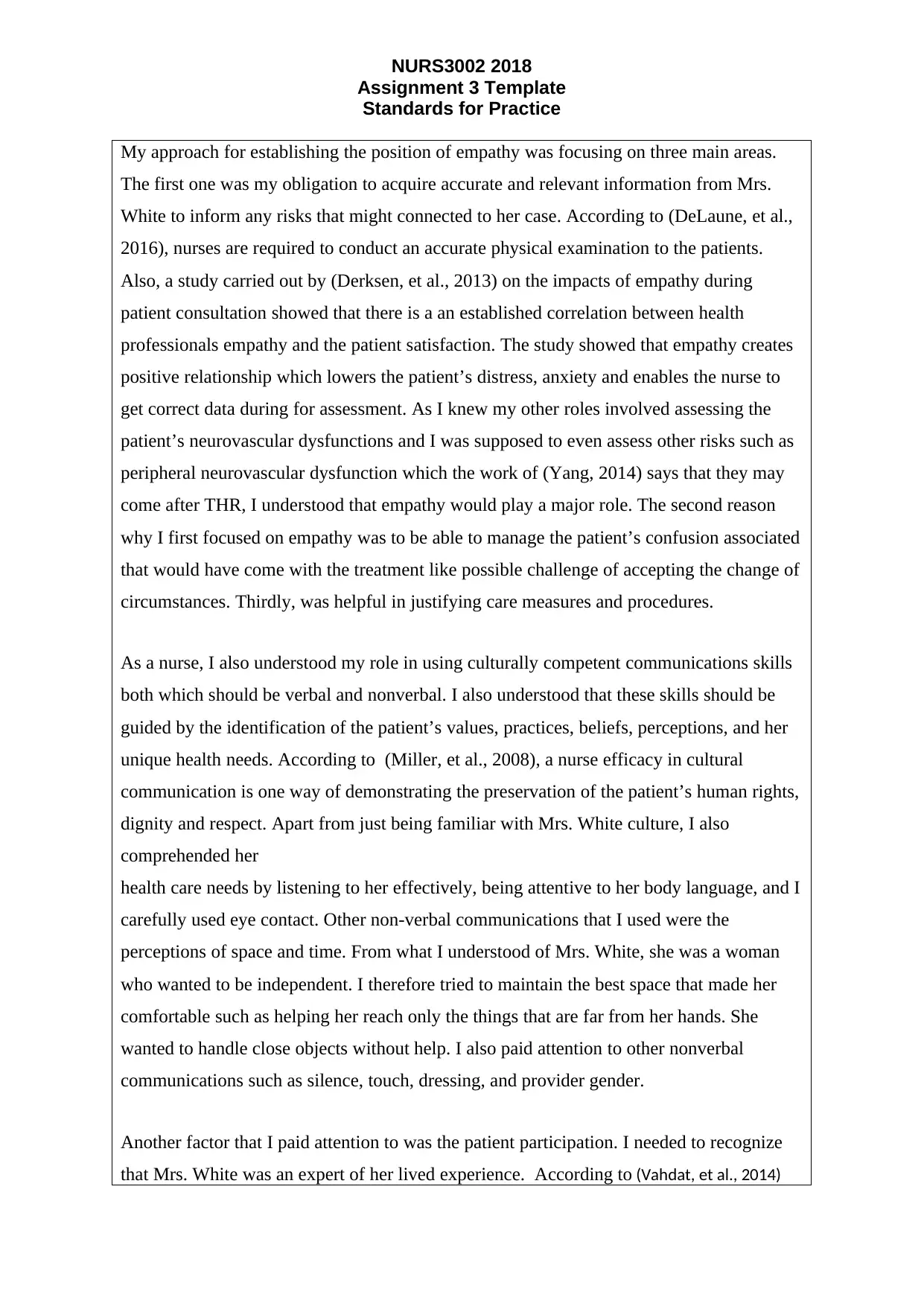
NURS3002 2018
Assignment 3 Template
Standards for Practice
My approach for establishing the position of empathy was focusing on three main areas.
The first one was my obligation to acquire accurate and relevant information from Mrs.
White to inform any risks that might connected to her case. According to (DeLaune, et al.,
2016), nurses are required to conduct an accurate physical examination to the patients.
Also, a study carried out by (Derksen, et al., 2013) on the impacts of empathy during
patient consultation showed that there is a an established correlation between health
professionals empathy and the patient satisfaction. The study showed that empathy creates
positive relationship which lowers the patient’s distress, anxiety and enables the nurse to
get correct data during for assessment. As I knew my other roles involved assessing the
patient’s neurovascular dysfunctions and I was supposed to even assess other risks such as
peripheral neurovascular dysfunction which the work of (Yang, 2014) says that they may
come after THR, I understood that empathy would play a major role. The second reason
why I first focused on empathy was to be able to manage the patient’s confusion associated
that would have come with the treatment like possible challenge of accepting the change of
circumstances. Thirdly, was helpful in justifying care measures and procedures.
As a nurse, I also understood my role in using culturally competent communications skills
both which should be verbal and nonverbal. I also understood that these skills should be
guided by the identification of the patient’s values, practices, beliefs, perceptions, and her
unique health needs. According to (Miller, et al., 2008), a nurse efficacy in cultural
communication is one way of demonstrating the preservation of the patient’s human rights,
dignity and respect. Apart from just being familiar with Mrs. White culture, I also
comprehended her
health care needs by listening to her effectively, being attentive to her body language, and I
carefully used eye contact. Other non-verbal communications that I used were the
perceptions of space and time. From what I understood of Mrs. White, she was a woman
who wanted to be independent. I therefore tried to maintain the best space that made her
comfortable such as helping her reach only the things that are far from her hands. She
wanted to handle close objects without help. I also paid attention to other nonverbal
communications such as silence, touch, dressing, and provider gender.
Another factor that I paid attention to was the patient participation. I needed to recognize
that Mrs. White was an expert of her lived experience. According to (Vahdat, et al., 2014)
Assignment 3 Template
Standards for Practice
My approach for establishing the position of empathy was focusing on three main areas.
The first one was my obligation to acquire accurate and relevant information from Mrs.
White to inform any risks that might connected to her case. According to (DeLaune, et al.,
2016), nurses are required to conduct an accurate physical examination to the patients.
Also, a study carried out by (Derksen, et al., 2013) on the impacts of empathy during
patient consultation showed that there is a an established correlation between health
professionals empathy and the patient satisfaction. The study showed that empathy creates
positive relationship which lowers the patient’s distress, anxiety and enables the nurse to
get correct data during for assessment. As I knew my other roles involved assessing the
patient’s neurovascular dysfunctions and I was supposed to even assess other risks such as
peripheral neurovascular dysfunction which the work of (Yang, 2014) says that they may
come after THR, I understood that empathy would play a major role. The second reason
why I first focused on empathy was to be able to manage the patient’s confusion associated
that would have come with the treatment like possible challenge of accepting the change of
circumstances. Thirdly, was helpful in justifying care measures and procedures.
As a nurse, I also understood my role in using culturally competent communications skills
both which should be verbal and nonverbal. I also understood that these skills should be
guided by the identification of the patient’s values, practices, beliefs, perceptions, and her
unique health needs. According to (Miller, et al., 2008), a nurse efficacy in cultural
communication is one way of demonstrating the preservation of the patient’s human rights,
dignity and respect. Apart from just being familiar with Mrs. White culture, I also
comprehended her
health care needs by listening to her effectively, being attentive to her body language, and I
carefully used eye contact. Other non-verbal communications that I used were the
perceptions of space and time. From what I understood of Mrs. White, she was a woman
who wanted to be independent. I therefore tried to maintain the best space that made her
comfortable such as helping her reach only the things that are far from her hands. She
wanted to handle close objects without help. I also paid attention to other nonverbal
communications such as silence, touch, dressing, and provider gender.
Another factor that I paid attention to was the patient participation. I needed to recognize
that Mrs. White was an expert of her lived experience. According to (Vahdat, et al., 2014)
Paraphrase This Document
Need a fresh take? Get an instant paraphrase of this document with our AI Paraphraser
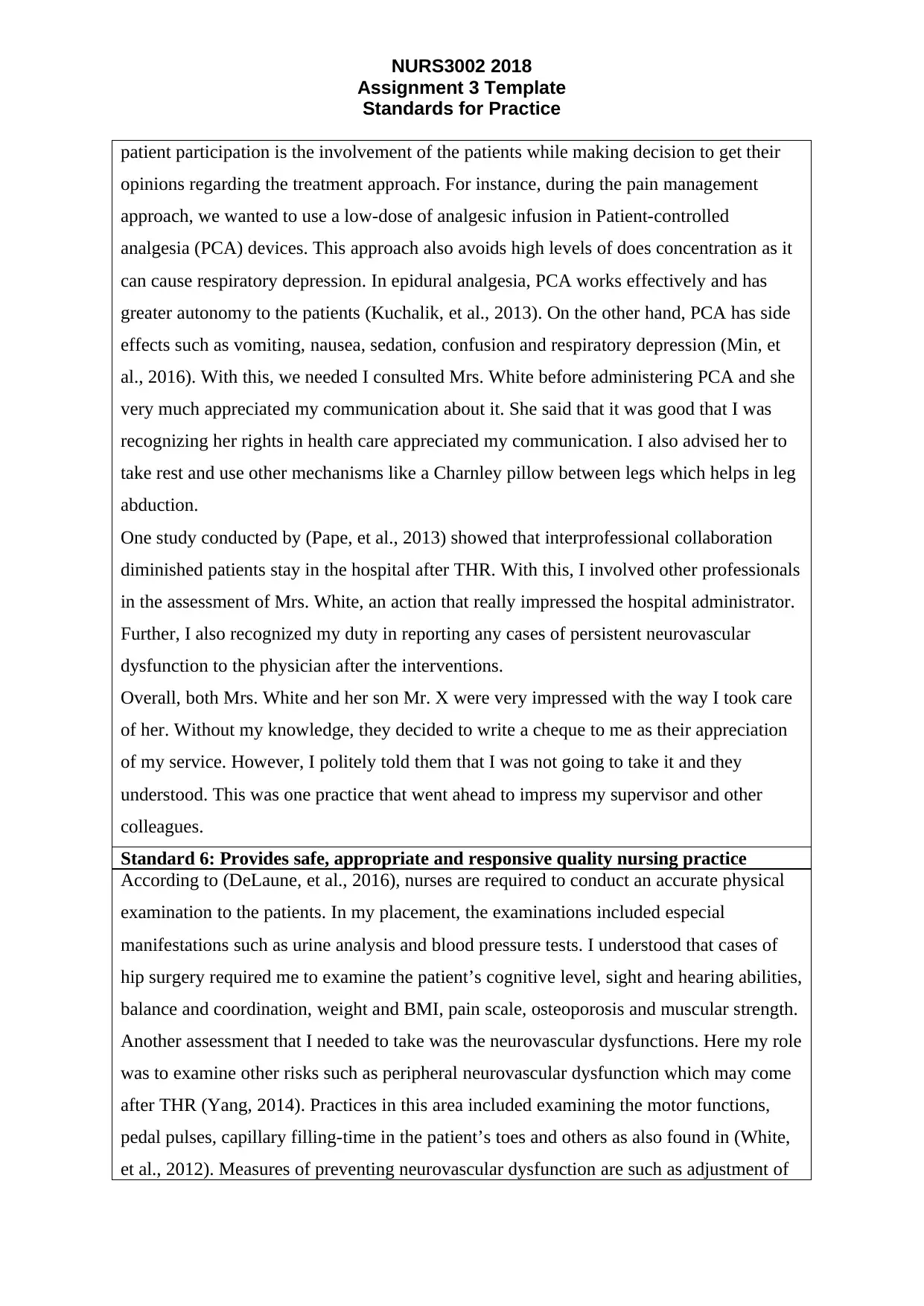
NURS3002 2018
Assignment 3 Template
Standards for Practice
patient participation is the involvement of the patients while making decision to get their
opinions regarding the treatment approach. For instance, during the pain management
approach, we wanted to use a low-dose of analgesic infusion in Patient-controlled
analgesia (PCA) devices. This approach also avoids high levels of does concentration as it
can cause respiratory depression. In epidural analgesia, PCA works effectively and has
greater autonomy to the patients (Kuchalik, et al., 2013). On the other hand, PCA has side
effects such as vomiting, nausea, sedation, confusion and respiratory depression (Min, et
al., 2016). With this, we needed I consulted Mrs. White before administering PCA and she
very much appreciated my communication about it. She said that it was good that I was
recognizing her rights in health care appreciated my communication. I also advised her to
take rest and use other mechanisms like a Charnley pillow between legs which helps in leg
abduction.
One study conducted by (Pape, et al., 2013) showed that interprofessional collaboration
diminished patients stay in the hospital after THR. With this, I involved other professionals
in the assessment of Mrs. White, an action that really impressed the hospital administrator.
Further, I also recognized my duty in reporting any cases of persistent neurovascular
dysfunction to the physician after the interventions.
Overall, both Mrs. White and her son Mr. X were very impressed with the way I took care
of her. Without my knowledge, they decided to write a cheque to me as their appreciation
of my service. However, I politely told them that I was not going to take it and they
understood. This was one practice that went ahead to impress my supervisor and other
colleagues.
Standard 6: Provides safe, appropriate and responsive quality nursing practice
According to (DeLaune, et al., 2016), nurses are required to conduct an accurate physical
examination to the patients. In my placement, the examinations included especial
manifestations such as urine analysis and blood pressure tests. I understood that cases of
hip surgery required me to examine the patient’s cognitive level, sight and hearing abilities,
balance and coordination, weight and BMI, pain scale, osteoporosis and muscular strength.
Another assessment that I needed to take was the neurovascular dysfunctions. Here my role
was to examine other risks such as peripheral neurovascular dysfunction which may come
after THR (Yang, 2014). Practices in this area included examining the motor functions,
pedal pulses, capillary filling-time in the patient’s toes and others as also found in (White,
et al., 2012). Measures of preventing neurovascular dysfunction are such as adjustment of
Assignment 3 Template
Standards for Practice
patient participation is the involvement of the patients while making decision to get their
opinions regarding the treatment approach. For instance, during the pain management
approach, we wanted to use a low-dose of analgesic infusion in Patient-controlled
analgesia (PCA) devices. This approach also avoids high levels of does concentration as it
can cause respiratory depression. In epidural analgesia, PCA works effectively and has
greater autonomy to the patients (Kuchalik, et al., 2013). On the other hand, PCA has side
effects such as vomiting, nausea, sedation, confusion and respiratory depression (Min, et
al., 2016). With this, we needed I consulted Mrs. White before administering PCA and she
very much appreciated my communication about it. She said that it was good that I was
recognizing her rights in health care appreciated my communication. I also advised her to
take rest and use other mechanisms like a Charnley pillow between legs which helps in leg
abduction.
One study conducted by (Pape, et al., 2013) showed that interprofessional collaboration
diminished patients stay in the hospital after THR. With this, I involved other professionals
in the assessment of Mrs. White, an action that really impressed the hospital administrator.
Further, I also recognized my duty in reporting any cases of persistent neurovascular
dysfunction to the physician after the interventions.
Overall, both Mrs. White and her son Mr. X were very impressed with the way I took care
of her. Without my knowledge, they decided to write a cheque to me as their appreciation
of my service. However, I politely told them that I was not going to take it and they
understood. This was one practice that went ahead to impress my supervisor and other
colleagues.
Standard 6: Provides safe, appropriate and responsive quality nursing practice
According to (DeLaune, et al., 2016), nurses are required to conduct an accurate physical
examination to the patients. In my placement, the examinations included especial
manifestations such as urine analysis and blood pressure tests. I understood that cases of
hip surgery required me to examine the patient’s cognitive level, sight and hearing abilities,
balance and coordination, weight and BMI, pain scale, osteoporosis and muscular strength.
Another assessment that I needed to take was the neurovascular dysfunctions. Here my role
was to examine other risks such as peripheral neurovascular dysfunction which may come
after THR (Yang, 2014). Practices in this area included examining the motor functions,
pedal pulses, capillary filling-time in the patient’s toes and others as also found in (White,
et al., 2012). Measures of preventing neurovascular dysfunction are such as adjustment of
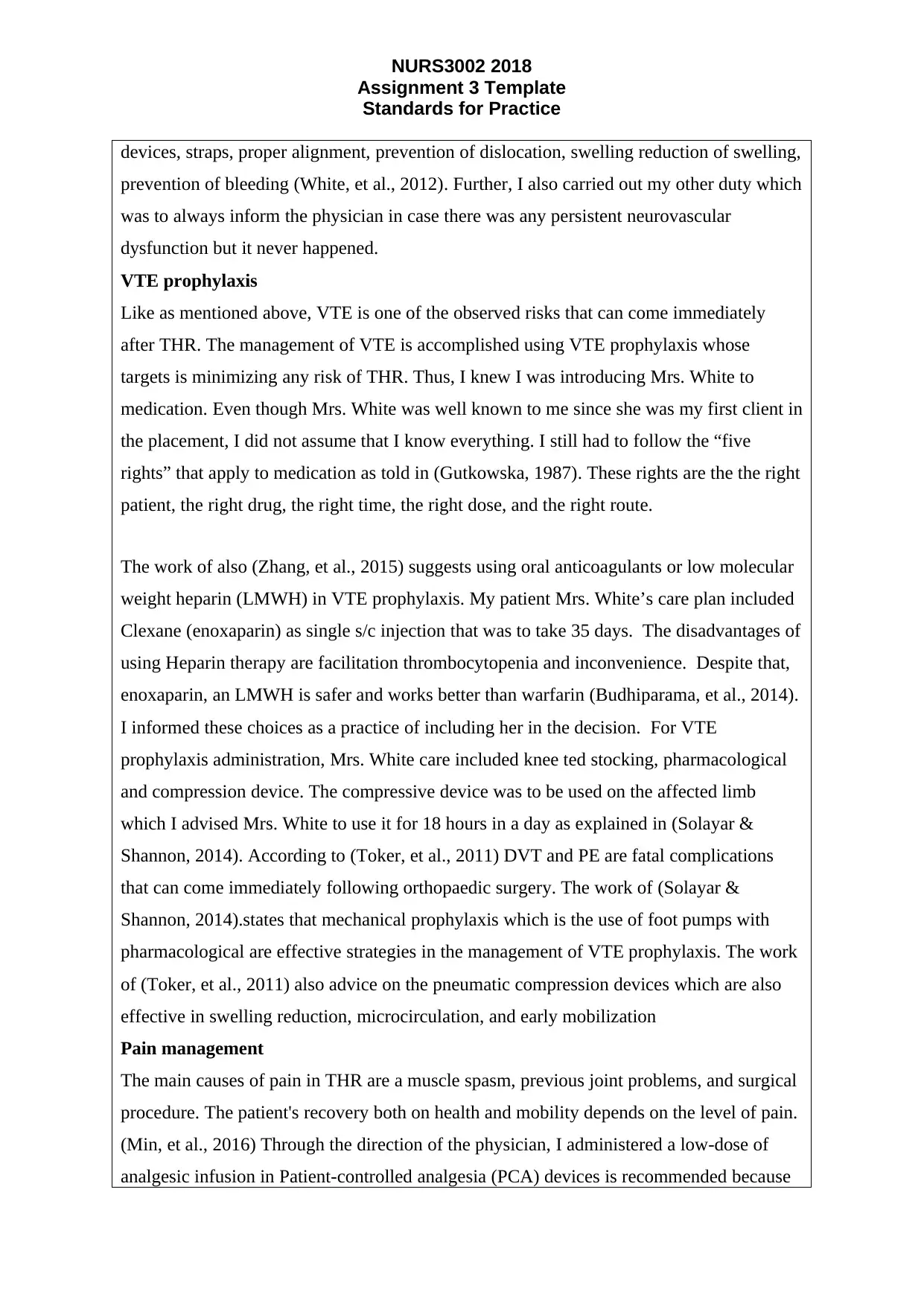
NURS3002 2018
Assignment 3 Template
Standards for Practice
devices, straps, proper alignment, prevention of dislocation, swelling reduction of swelling,
prevention of bleeding (White, et al., 2012). Further, I also carried out my other duty which
was to always inform the physician in case there was any persistent neurovascular
dysfunction but it never happened.
VTE prophylaxis
Like as mentioned above, VTE is one of the observed risks that can come immediately
after THR. The management of VTE is accomplished using VTE prophylaxis whose
targets is minimizing any risk of THR. Thus, I knew I was introducing Mrs. White to
medication. Even though Mrs. White was well known to me since she was my first client in
the placement, I did not assume that I know everything. I still had to follow the “five
rights” that apply to medication as told in (Gutkowska, 1987). These rights are the the right
patient, the right drug, the right time, the right dose, and the right route.
The work of also (Zhang, et al., 2015) suggests using oral anticoagulants or low molecular
weight heparin (LMWH) in VTE prophylaxis. My patient Mrs. White’s care plan included
Clexane (enoxaparin) as single s/c injection that was to take 35 days. The disadvantages of
using Heparin therapy are facilitation thrombocytopenia and inconvenience. Despite that,
enoxaparin, an LMWH is safer and works better than warfarin (Budhiparama, et al., 2014).
I informed these choices as a practice of including her in the decision. For VTE
prophylaxis administration, Mrs. White care included knee ted stocking, pharmacological
and compression device. The compressive device was to be used on the affected limb
which I advised Mrs. White to use it for 18 hours in a day as explained in (Solayar &
Shannon, 2014). According to (Toker, et al., 2011) DVT and PE are fatal complications
that can come immediately following orthopaedic surgery. The work of (Solayar &
Shannon, 2014).states that mechanical prophylaxis which is the use of foot pumps with
pharmacological are effective strategies in the management of VTE prophylaxis. The work
of (Toker, et al., 2011) also advice on the pneumatic compression devices which are also
effective in swelling reduction, microcirculation, and early mobilization
Pain management
The main causes of pain in THR are a muscle spasm, previous joint problems, and surgical
procedure. The patient's recovery both on health and mobility depends on the level of pain.
(Min, et al., 2016) Through the direction of the physician, I administered a low-dose of
analgesic infusion in Patient-controlled analgesia (PCA) devices is recommended because
Assignment 3 Template
Standards for Practice
devices, straps, proper alignment, prevention of dislocation, swelling reduction of swelling,
prevention of bleeding (White, et al., 2012). Further, I also carried out my other duty which
was to always inform the physician in case there was any persistent neurovascular
dysfunction but it never happened.
VTE prophylaxis
Like as mentioned above, VTE is one of the observed risks that can come immediately
after THR. The management of VTE is accomplished using VTE prophylaxis whose
targets is minimizing any risk of THR. Thus, I knew I was introducing Mrs. White to
medication. Even though Mrs. White was well known to me since she was my first client in
the placement, I did not assume that I know everything. I still had to follow the “five
rights” that apply to medication as told in (Gutkowska, 1987). These rights are the the right
patient, the right drug, the right time, the right dose, and the right route.
The work of also (Zhang, et al., 2015) suggests using oral anticoagulants or low molecular
weight heparin (LMWH) in VTE prophylaxis. My patient Mrs. White’s care plan included
Clexane (enoxaparin) as single s/c injection that was to take 35 days. The disadvantages of
using Heparin therapy are facilitation thrombocytopenia and inconvenience. Despite that,
enoxaparin, an LMWH is safer and works better than warfarin (Budhiparama, et al., 2014).
I informed these choices as a practice of including her in the decision. For VTE
prophylaxis administration, Mrs. White care included knee ted stocking, pharmacological
and compression device. The compressive device was to be used on the affected limb
which I advised Mrs. White to use it for 18 hours in a day as explained in (Solayar &
Shannon, 2014). According to (Toker, et al., 2011) DVT and PE are fatal complications
that can come immediately following orthopaedic surgery. The work of (Solayar &
Shannon, 2014).states that mechanical prophylaxis which is the use of foot pumps with
pharmacological are effective strategies in the management of VTE prophylaxis. The work
of (Toker, et al., 2011) also advice on the pneumatic compression devices which are also
effective in swelling reduction, microcirculation, and early mobilization
Pain management
The main causes of pain in THR are a muscle spasm, previous joint problems, and surgical
procedure. The patient's recovery both on health and mobility depends on the level of pain.
(Min, et al., 2016) Through the direction of the physician, I administered a low-dose of
analgesic infusion in Patient-controlled analgesia (PCA) devices is recommended because
⊘ This is a preview!⊘
Do you want full access?
Subscribe today to unlock all pages.

Trusted by 1+ million students worldwide
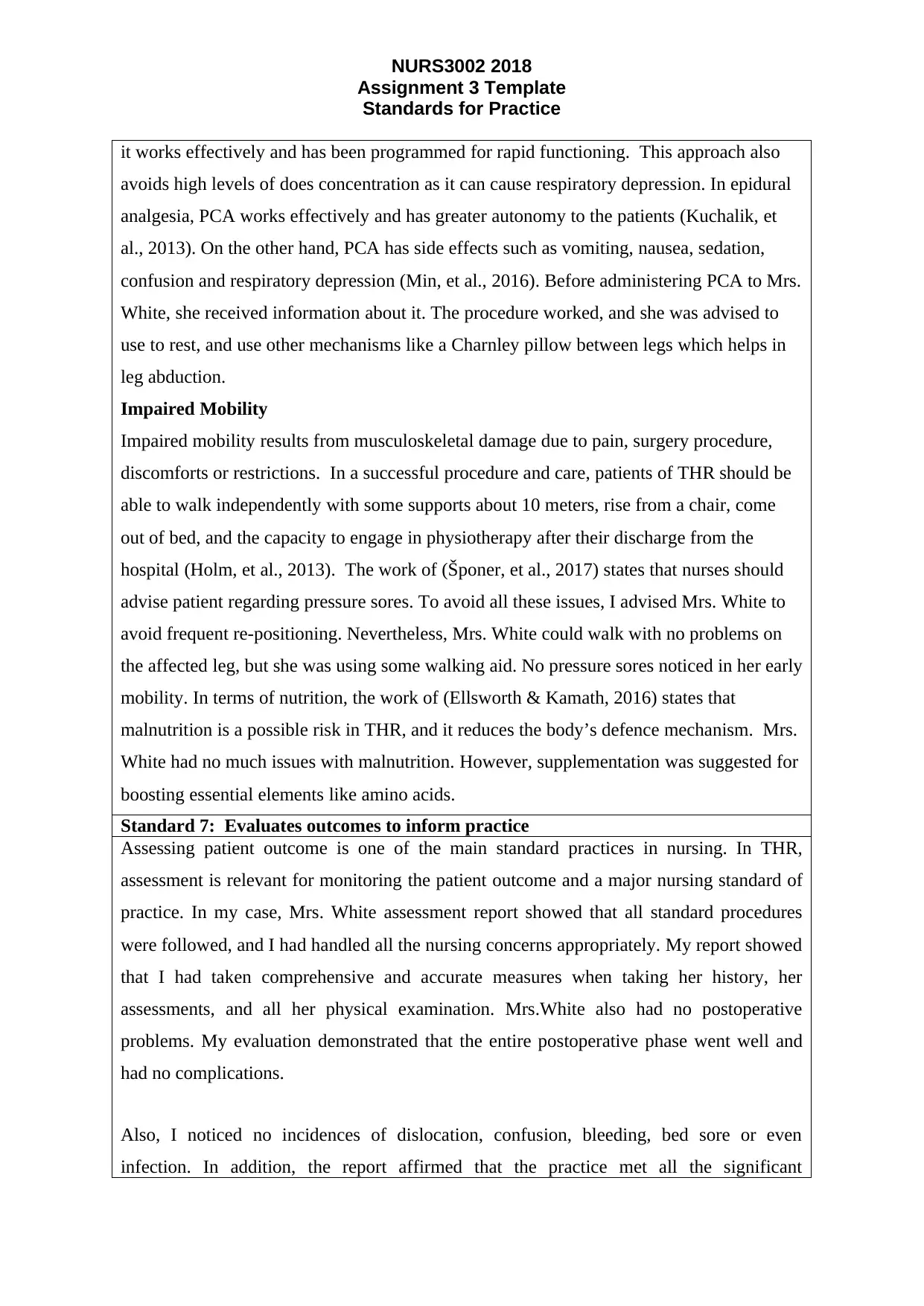
NURS3002 2018
Assignment 3 Template
Standards for Practice
it works effectively and has been programmed for rapid functioning. This approach also
avoids high levels of does concentration as it can cause respiratory depression. In epidural
analgesia, PCA works effectively and has greater autonomy to the patients (Kuchalik, et
al., 2013). On the other hand, PCA has side effects such as vomiting, nausea, sedation,
confusion and respiratory depression (Min, et al., 2016). Before administering PCA to Mrs.
White, she received information about it. The procedure worked, and she was advised to
use to rest, and use other mechanisms like a Charnley pillow between legs which helps in
leg abduction.
Impaired Mobility
Impaired mobility results from musculoskeletal damage due to pain, surgery procedure,
discomforts or restrictions. In a successful procedure and care, patients of THR should be
able to walk independently with some supports about 10 meters, rise from a chair, come
out of bed, and the capacity to engage in physiotherapy after their discharge from the
hospital (Holm, et al., 2013). The work of (Šponer, et al., 2017) states that nurses should
advise patient regarding pressure sores. To avoid all these issues, I advised Mrs. White to
avoid frequent re-positioning. Nevertheless, Mrs. White could walk with no problems on
the affected leg, but she was using some walking aid. No pressure sores noticed in her early
mobility. In terms of nutrition, the work of (Ellsworth & Kamath, 2016) states that
malnutrition is a possible risk in THR, and it reduces the body’s defence mechanism. Mrs.
White had no much issues with malnutrition. However, supplementation was suggested for
boosting essential elements like amino acids.
Standard 7: Evaluates outcomes to inform practice
Assessing patient outcome is one of the main standard practices in nursing. In THR,
assessment is relevant for monitoring the patient outcome and a major nursing standard of
practice. In my case, Mrs. White assessment report showed that all standard procedures
were followed, and I had handled all the nursing concerns appropriately. My report showed
that I had taken comprehensive and accurate measures when taking her history, her
assessments, and all her physical examination. Mrs.White also had no postoperative
problems. My evaluation demonstrated that the entire postoperative phase went well and
had no complications.
Also, I noticed no incidences of dislocation, confusion, bleeding, bed sore or even
infection. In addition, the report affirmed that the practice met all the significant
Assignment 3 Template
Standards for Practice
it works effectively and has been programmed for rapid functioning. This approach also
avoids high levels of does concentration as it can cause respiratory depression. In epidural
analgesia, PCA works effectively and has greater autonomy to the patients (Kuchalik, et
al., 2013). On the other hand, PCA has side effects such as vomiting, nausea, sedation,
confusion and respiratory depression (Min, et al., 2016). Before administering PCA to Mrs.
White, she received information about it. The procedure worked, and she was advised to
use to rest, and use other mechanisms like a Charnley pillow between legs which helps in
leg abduction.
Impaired Mobility
Impaired mobility results from musculoskeletal damage due to pain, surgery procedure,
discomforts or restrictions. In a successful procedure and care, patients of THR should be
able to walk independently with some supports about 10 meters, rise from a chair, come
out of bed, and the capacity to engage in physiotherapy after their discharge from the
hospital (Holm, et al., 2013). The work of (Šponer, et al., 2017) states that nurses should
advise patient regarding pressure sores. To avoid all these issues, I advised Mrs. White to
avoid frequent re-positioning. Nevertheless, Mrs. White could walk with no problems on
the affected leg, but she was using some walking aid. No pressure sores noticed in her early
mobility. In terms of nutrition, the work of (Ellsworth & Kamath, 2016) states that
malnutrition is a possible risk in THR, and it reduces the body’s defence mechanism. Mrs.
White had no much issues with malnutrition. However, supplementation was suggested for
boosting essential elements like amino acids.
Standard 7: Evaluates outcomes to inform practice
Assessing patient outcome is one of the main standard practices in nursing. In THR,
assessment is relevant for monitoring the patient outcome and a major nursing standard of
practice. In my case, Mrs. White assessment report showed that all standard procedures
were followed, and I had handled all the nursing concerns appropriately. My report showed
that I had taken comprehensive and accurate measures when taking her history, her
assessments, and all her physical examination. Mrs.White also had no postoperative
problems. My evaluation demonstrated that the entire postoperative phase went well and
had no complications.
Also, I noticed no incidences of dislocation, confusion, bleeding, bed sore or even
infection. In addition, the report affirmed that the practice met all the significant
Paraphrase This Document
Need a fresh take? Get an instant paraphrase of this document with our AI Paraphraser
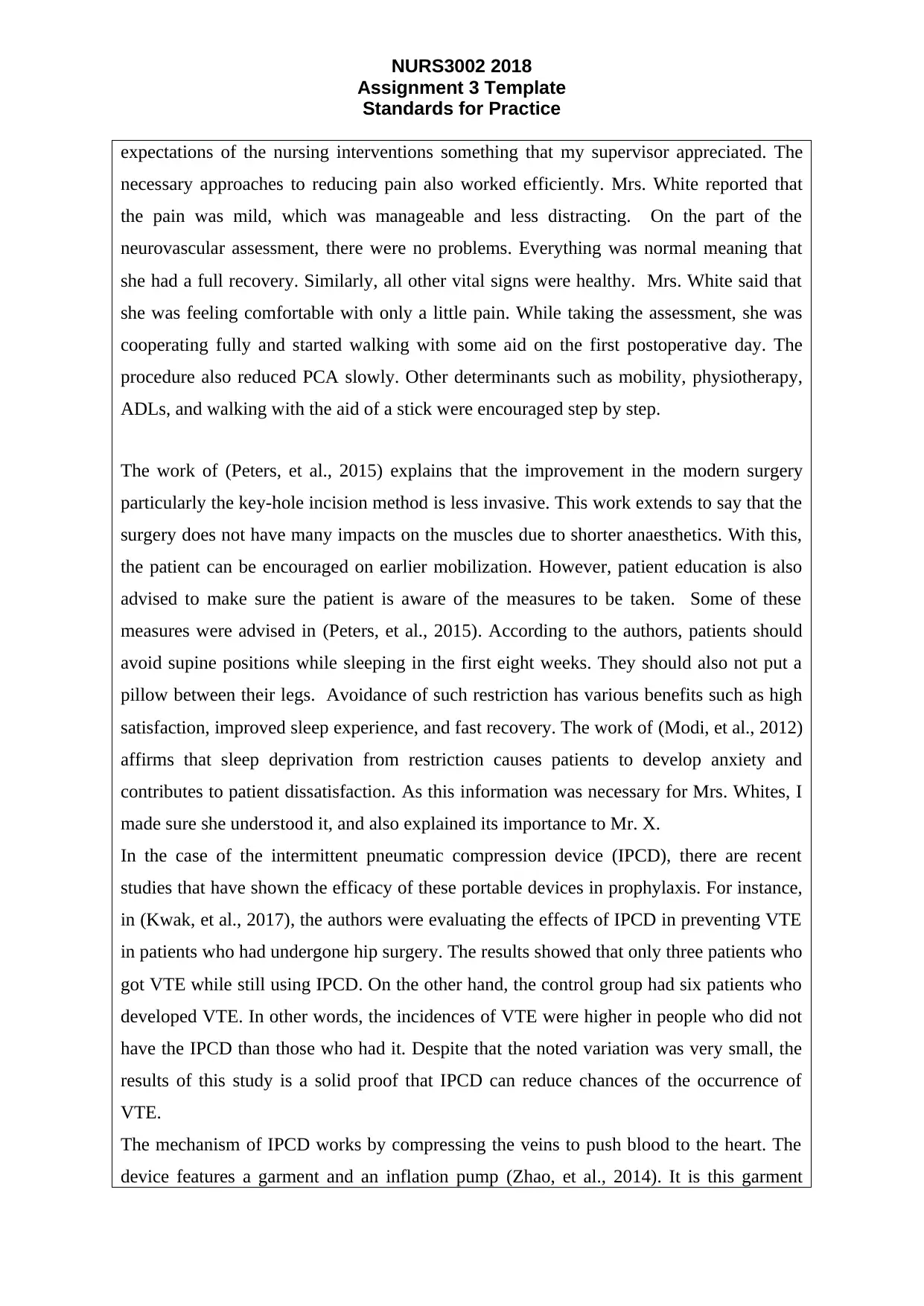
NURS3002 2018
Assignment 3 Template
Standards for Practice
expectations of the nursing interventions something that my supervisor appreciated. The
necessary approaches to reducing pain also worked efficiently. Mrs. White reported that
the pain was mild, which was manageable and less distracting. On the part of the
neurovascular assessment, there were no problems. Everything was normal meaning that
she had a full recovery. Similarly, all other vital signs were healthy. Mrs. White said that
she was feeling comfortable with only a little pain. While taking the assessment, she was
cooperating fully and started walking with some aid on the first postoperative day. The
procedure also reduced PCA slowly. Other determinants such as mobility, physiotherapy,
ADLs, and walking with the aid of a stick were encouraged step by step.
The work of (Peters, et al., 2015) explains that the improvement in the modern surgery
particularly the key-hole incision method is less invasive. This work extends to say that the
surgery does not have many impacts on the muscles due to shorter anaesthetics. With this,
the patient can be encouraged on earlier mobilization. However, patient education is also
advised to make sure the patient is aware of the measures to be taken. Some of these
measures were advised in (Peters, et al., 2015). According to the authors, patients should
avoid supine positions while sleeping in the first eight weeks. They should also not put a
pillow between their legs. Avoidance of such restriction has various benefits such as high
satisfaction, improved sleep experience, and fast recovery. The work of (Modi, et al., 2012)
affirms that sleep deprivation from restriction causes patients to develop anxiety and
contributes to patient dissatisfaction. As this information was necessary for Mrs. Whites, I
made sure she understood it, and also explained its importance to Mr. X.
In the case of the intermittent pneumatic compression device (IPCD), there are recent
studies that have shown the efficacy of these portable devices in prophylaxis. For instance,
in (Kwak, et al., 2017), the authors were evaluating the effects of IPCD in preventing VTE
in patients who had undergone hip surgery. The results showed that only three patients who
got VTE while still using IPCD. On the other hand, the control group had six patients who
developed VTE. In other words, the incidences of VTE were higher in people who did not
have the IPCD than those who had it. Despite that the noted variation was very small, the
results of this study is a solid proof that IPCD can reduce chances of the occurrence of
VTE.
The mechanism of IPCD works by compressing the veins to push blood to the heart. The
device features a garment and an inflation pump (Zhao, et al., 2014). It is this garment
Assignment 3 Template
Standards for Practice
expectations of the nursing interventions something that my supervisor appreciated. The
necessary approaches to reducing pain also worked efficiently. Mrs. White reported that
the pain was mild, which was manageable and less distracting. On the part of the
neurovascular assessment, there were no problems. Everything was normal meaning that
she had a full recovery. Similarly, all other vital signs were healthy. Mrs. White said that
she was feeling comfortable with only a little pain. While taking the assessment, she was
cooperating fully and started walking with some aid on the first postoperative day. The
procedure also reduced PCA slowly. Other determinants such as mobility, physiotherapy,
ADLs, and walking with the aid of a stick were encouraged step by step.
The work of (Peters, et al., 2015) explains that the improvement in the modern surgery
particularly the key-hole incision method is less invasive. This work extends to say that the
surgery does not have many impacts on the muscles due to shorter anaesthetics. With this,
the patient can be encouraged on earlier mobilization. However, patient education is also
advised to make sure the patient is aware of the measures to be taken. Some of these
measures were advised in (Peters, et al., 2015). According to the authors, patients should
avoid supine positions while sleeping in the first eight weeks. They should also not put a
pillow between their legs. Avoidance of such restriction has various benefits such as high
satisfaction, improved sleep experience, and fast recovery. The work of (Modi, et al., 2012)
affirms that sleep deprivation from restriction causes patients to develop anxiety and
contributes to patient dissatisfaction. As this information was necessary for Mrs. Whites, I
made sure she understood it, and also explained its importance to Mr. X.
In the case of the intermittent pneumatic compression device (IPCD), there are recent
studies that have shown the efficacy of these portable devices in prophylaxis. For instance,
in (Kwak, et al., 2017), the authors were evaluating the effects of IPCD in preventing VTE
in patients who had undergone hip surgery. The results showed that only three patients who
got VTE while still using IPCD. On the other hand, the control group had six patients who
developed VTE. In other words, the incidences of VTE were higher in people who did not
have the IPCD than those who had it. Despite that the noted variation was very small, the
results of this study is a solid proof that IPCD can reduce chances of the occurrence of
VTE.
The mechanism of IPCD works by compressing the veins to push blood to the heart. The
device features a garment and an inflation pump (Zhao, et al., 2014). It is this garment
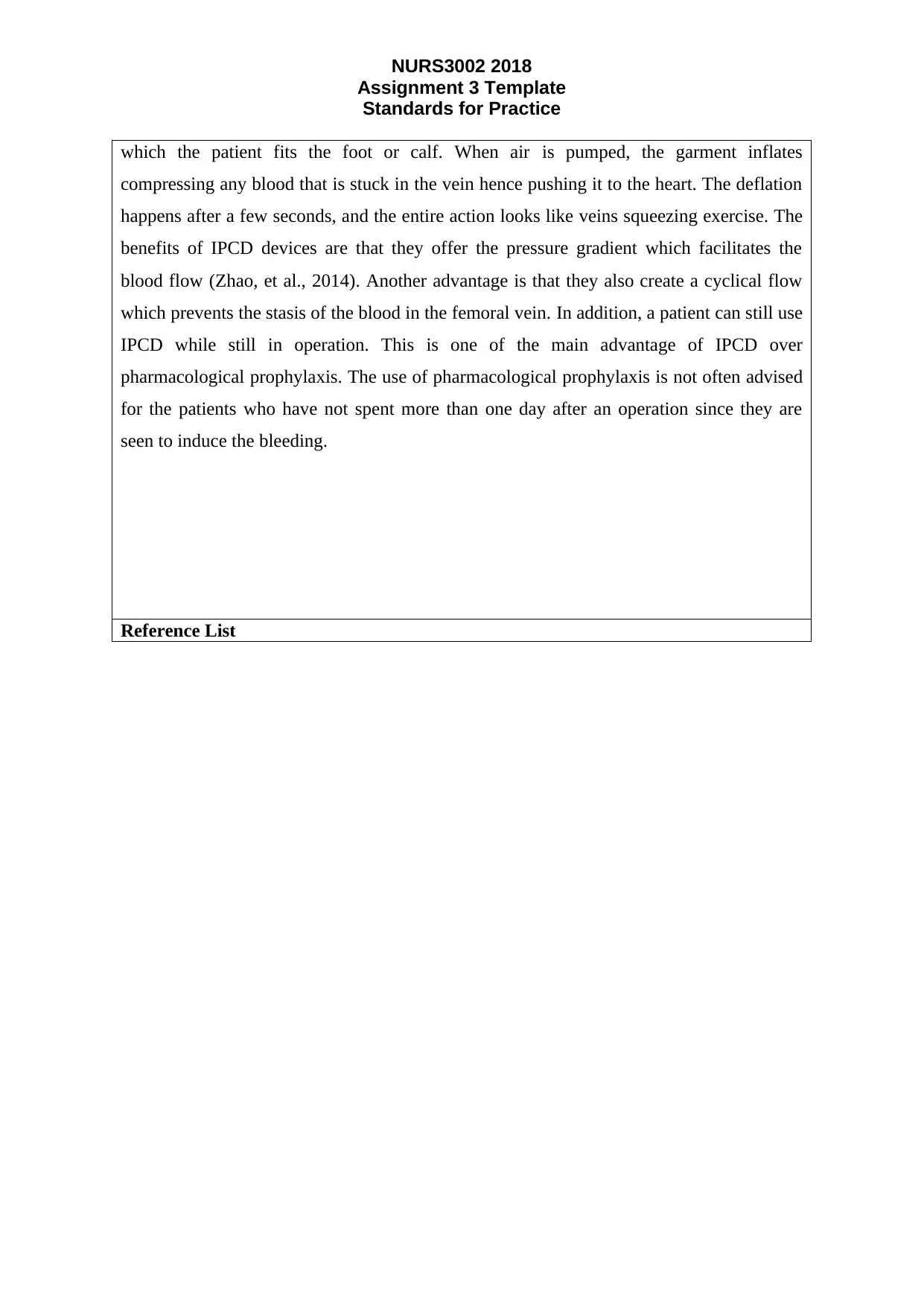
NURS3002 2018
Assignment 3 Template
Standards for Practice
which the patient fits the foot or calf. When air is pumped, the garment inflates
compressing any blood that is stuck in the vein hence pushing it to the heart. The deflation
happens after a few seconds, and the entire action looks like veins squeezing exercise. The
benefits of IPCD devices are that they offer the pressure gradient which facilitates the
blood flow (Zhao, et al., 2014). Another advantage is that they also create a cyclical flow
which prevents the stasis of the blood in the femoral vein. In addition, a patient can still use
IPCD while still in operation. This is one of the main advantage of IPCD over
pharmacological prophylaxis. The use of pharmacological prophylaxis is not often advised
for the patients who have not spent more than one day after an operation since they are
seen to induce the bleeding.
Reference List
Assignment 3 Template
Standards for Practice
which the patient fits the foot or calf. When air is pumped, the garment inflates
compressing any blood that is stuck in the vein hence pushing it to the heart. The deflation
happens after a few seconds, and the entire action looks like veins squeezing exercise. The
benefits of IPCD devices are that they offer the pressure gradient which facilitates the
blood flow (Zhao, et al., 2014). Another advantage is that they also create a cyclical flow
which prevents the stasis of the blood in the femoral vein. In addition, a patient can still use
IPCD while still in operation. This is one of the main advantage of IPCD over
pharmacological prophylaxis. The use of pharmacological prophylaxis is not often advised
for the patients who have not spent more than one day after an operation since they are
seen to induce the bleeding.
Reference List
⊘ This is a preview!⊘
Do you want full access?
Subscribe today to unlock all pages.

Trusted by 1+ million students worldwide
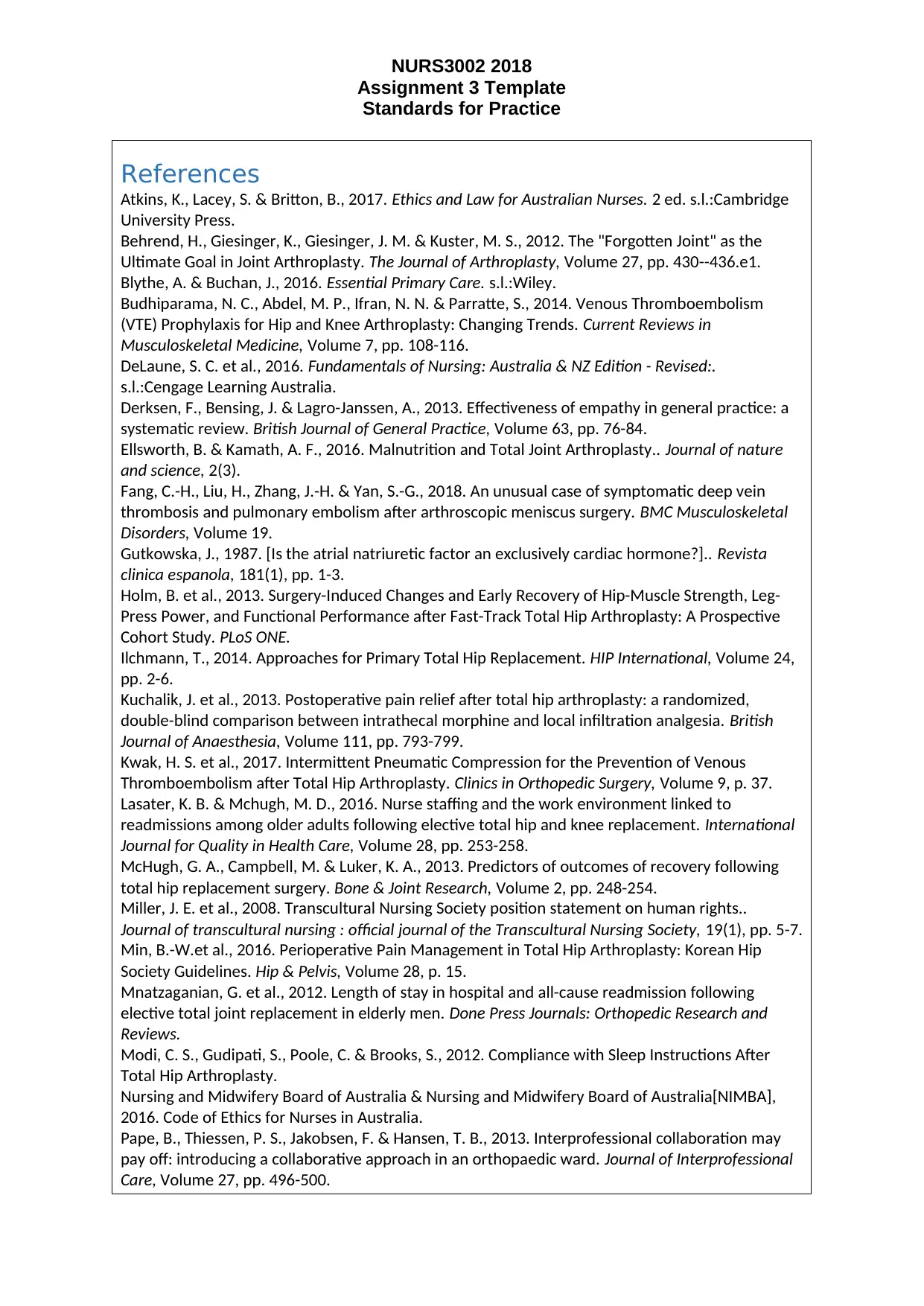
NURS3002 2018
Assignment 3 Template
Standards for Practice
References
Atkins, K., Lacey, S. & Britton, B., 2017. Ethics and Law for Australian Nurses. 2 ed. s.l.:Cambridge
University Press.
Behrend, H., Giesinger, K., Giesinger, J. M. & Kuster, M. S., 2012. The "Forgotten Joint" as the
Ultimate Goal in Joint Arthroplasty. The Journal of Arthroplasty, Volume 27, pp. 430--436.e1.
Blythe, A. & Buchan, J., 2016. Essential Primary Care. s.l.:Wiley.
Budhiparama, N. C., Abdel, M. P., Ifran, N. N. & Parratte, S., 2014. Venous Thromboembolism
(VTE) Prophylaxis for Hip and Knee Arthroplasty: Changing Trends. Current Reviews in
Musculoskeletal Medicine, Volume 7, pp. 108-116.
DeLaune, S. C. et al., 2016. Fundamentals of Nursing: Australia & NZ Edition - Revised:.
s.l.:Cengage Learning Australia.
Derksen, F., Bensing, J. & Lagro-Janssen, A., 2013. Effectiveness of empathy in general practice: a
systematic review. British Journal of General Practice, Volume 63, pp. 76-84.
Ellsworth, B. & Kamath, A. F., 2016. Malnutrition and Total Joint Arthroplasty.. Journal of nature
and science, 2(3).
Fang, C.-H., Liu, H., Zhang, J.-H. & Yan, S.-G., 2018. An unusual case of symptomatic deep vein
thrombosis and pulmonary embolism after arthroscopic meniscus surgery. BMC Musculoskeletal
Disorders, Volume 19.
Gutkowska, J., 1987. [Is the atrial natriuretic factor an exclusively cardiac hormone?].. Revista
clinica espanola, 181(1), pp. 1-3.
Holm, B. et al., 2013. Surgery-Induced Changes and Early Recovery of Hip-Muscle Strength, Leg-
Press Power, and Functional Performance after Fast-Track Total Hip Arthroplasty: A Prospective
Cohort Study. PLoS ONE.
Ilchmann, T., 2014. Approaches for Primary Total Hip Replacement. HIP International, Volume 24,
pp. 2-6.
Kuchalik, J. et al., 2013. Postoperative pain relief after total hip arthroplasty: a randomized,
double-blind comparison between intrathecal morphine and local infiltration analgesia. British
Journal of Anaesthesia, Volume 111, pp. 793-799.
Kwak, H. S. et al., 2017. Intermittent Pneumatic Compression for the Prevention of Venous
Thromboembolism after Total Hip Arthroplasty. Clinics in Orthopedic Surgery, Volume 9, p. 37.
Lasater, K. B. & Mchugh, M. D., 2016. Nurse staffing and the work environment linked to
readmissions among older adults following elective total hip and knee replacement. International
Journal for Quality in Health Care, Volume 28, pp. 253-258.
McHugh, G. A., Campbell, M. & Luker, K. A., 2013. Predictors of outcomes of recovery following
total hip replacement surgery. Bone & Joint Research, Volume 2, pp. 248-254.
Miller, J. E. et al., 2008. Transcultural Nursing Society position statement on human rights..
Journal of transcultural nursing : official journal of the Transcultural Nursing Society, 19(1), pp. 5-7.
Min, B.-W.et al., 2016. Perioperative Pain Management in Total Hip Arthroplasty: Korean Hip
Society Guidelines. Hip & Pelvis, Volume 28, p. 15.
Mnatzaganian, G. et al., 2012. Length of stay in hospital and all-cause readmission following
elective total joint replacement in elderly men. Done Press Journals: Orthopedic Research and
Reviews.
Modi, C. S., Gudipati, S., Poole, C. & Brooks, S., 2012. Compliance with Sleep Instructions After
Total Hip Arthroplasty.
Nursing and Midwifery Board of Australia & Nursing and Midwifery Board of Australia[NIMBA],
2016. Code of Ethics for Nurses in Australia.
Pape, B., Thiessen, P. S., Jakobsen, F. & Hansen, T. B., 2013. Interprofessional collaboration may
pay off: introducing a collaborative approach in an orthopaedic ward. Journal of Interprofessional
Care, Volume 27, pp. 496-500.
Assignment 3 Template
Standards for Practice
References
Atkins, K., Lacey, S. & Britton, B., 2017. Ethics and Law for Australian Nurses. 2 ed. s.l.:Cambridge
University Press.
Behrend, H., Giesinger, K., Giesinger, J. M. & Kuster, M. S., 2012. The "Forgotten Joint" as the
Ultimate Goal in Joint Arthroplasty. The Journal of Arthroplasty, Volume 27, pp. 430--436.e1.
Blythe, A. & Buchan, J., 2016. Essential Primary Care. s.l.:Wiley.
Budhiparama, N. C., Abdel, M. P., Ifran, N. N. & Parratte, S., 2014. Venous Thromboembolism
(VTE) Prophylaxis for Hip and Knee Arthroplasty: Changing Trends. Current Reviews in
Musculoskeletal Medicine, Volume 7, pp. 108-116.
DeLaune, S. C. et al., 2016. Fundamentals of Nursing: Australia & NZ Edition - Revised:.
s.l.:Cengage Learning Australia.
Derksen, F., Bensing, J. & Lagro-Janssen, A., 2013. Effectiveness of empathy in general practice: a
systematic review. British Journal of General Practice, Volume 63, pp. 76-84.
Ellsworth, B. & Kamath, A. F., 2016. Malnutrition and Total Joint Arthroplasty.. Journal of nature
and science, 2(3).
Fang, C.-H., Liu, H., Zhang, J.-H. & Yan, S.-G., 2018. An unusual case of symptomatic deep vein
thrombosis and pulmonary embolism after arthroscopic meniscus surgery. BMC Musculoskeletal
Disorders, Volume 19.
Gutkowska, J., 1987. [Is the atrial natriuretic factor an exclusively cardiac hormone?].. Revista
clinica espanola, 181(1), pp. 1-3.
Holm, B. et al., 2013. Surgery-Induced Changes and Early Recovery of Hip-Muscle Strength, Leg-
Press Power, and Functional Performance after Fast-Track Total Hip Arthroplasty: A Prospective
Cohort Study. PLoS ONE.
Ilchmann, T., 2014. Approaches for Primary Total Hip Replacement. HIP International, Volume 24,
pp. 2-6.
Kuchalik, J. et al., 2013. Postoperative pain relief after total hip arthroplasty: a randomized,
double-blind comparison between intrathecal morphine and local infiltration analgesia. British
Journal of Anaesthesia, Volume 111, pp. 793-799.
Kwak, H. S. et al., 2017. Intermittent Pneumatic Compression for the Prevention of Venous
Thromboembolism after Total Hip Arthroplasty. Clinics in Orthopedic Surgery, Volume 9, p. 37.
Lasater, K. B. & Mchugh, M. D., 2016. Nurse staffing and the work environment linked to
readmissions among older adults following elective total hip and knee replacement. International
Journal for Quality in Health Care, Volume 28, pp. 253-258.
McHugh, G. A., Campbell, M. & Luker, K. A., 2013. Predictors of outcomes of recovery following
total hip replacement surgery. Bone & Joint Research, Volume 2, pp. 248-254.
Miller, J. E. et al., 2008. Transcultural Nursing Society position statement on human rights..
Journal of transcultural nursing : official journal of the Transcultural Nursing Society, 19(1), pp. 5-7.
Min, B.-W.et al., 2016. Perioperative Pain Management in Total Hip Arthroplasty: Korean Hip
Society Guidelines. Hip & Pelvis, Volume 28, p. 15.
Mnatzaganian, G. et al., 2012. Length of stay in hospital and all-cause readmission following
elective total joint replacement in elderly men. Done Press Journals: Orthopedic Research and
Reviews.
Modi, C. S., Gudipati, S., Poole, C. & Brooks, S., 2012. Compliance with Sleep Instructions After
Total Hip Arthroplasty.
Nursing and Midwifery Board of Australia & Nursing and Midwifery Board of Australia[NIMBA],
2016. Code of Ethics for Nurses in Australia.
Pape, B., Thiessen, P. S., Jakobsen, F. & Hansen, T. B., 2013. Interprofessional collaboration may
pay off: introducing a collaborative approach in an orthopaedic ward. Journal of Interprofessional
Care, Volume 27, pp. 496-500.
Paraphrase This Document
Need a fresh take? Get an instant paraphrase of this document with our AI Paraphraser
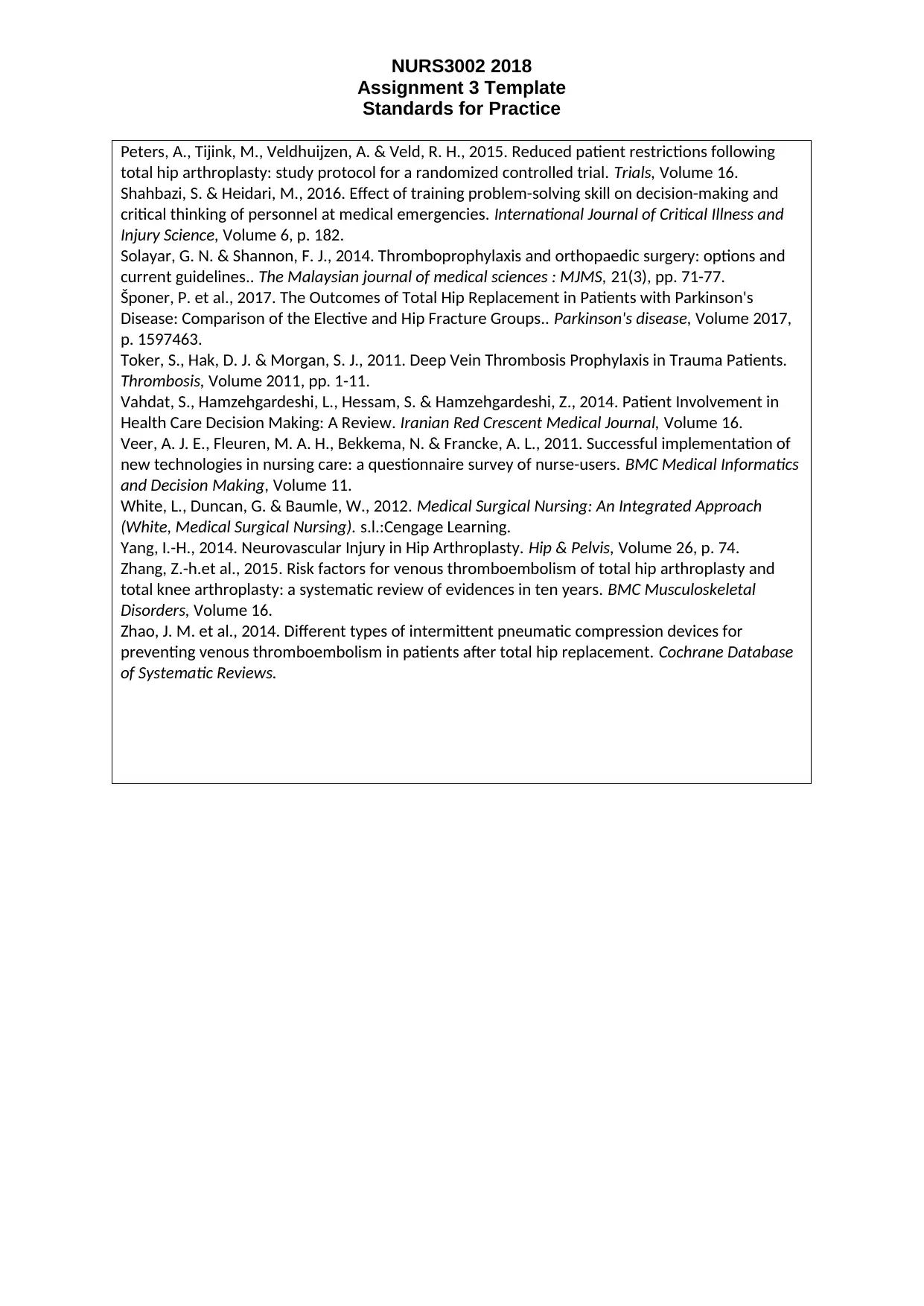
NURS3002 2018
Assignment 3 Template
Standards for Practice
Peters, A., Tijink, M., Veldhuijzen, A. & Veld, R. H., 2015. Reduced patient restrictions following
total hip arthroplasty: study protocol for a randomized controlled trial. Trials, Volume 16.
Shahbazi, S. & Heidari, M., 2016. Effect of training problem-solving skill on decision-making and
critical thinking of personnel at medical emergencies. International Journal of Critical Illness and
Injury Science, Volume 6, p. 182.
Solayar, G. N. & Shannon, F. J., 2014. Thromboprophylaxis and orthopaedic surgery: options and
current guidelines.. The Malaysian journal of medical sciences : MJMS, 21(3), pp. 71-77.
Šponer, P. et al., 2017. The Outcomes of Total Hip Replacement in Patients with Parkinson's
Disease: Comparison of the Elective and Hip Fracture Groups.. Parkinson's disease, Volume 2017,
p. 1597463.
Toker, S., Hak, D. J. & Morgan, S. J., 2011. Deep Vein Thrombosis Prophylaxis in Trauma Patients.
Thrombosis, Volume 2011, pp. 1-11.
Vahdat, S., Hamzehgardeshi, L., Hessam, S. & Hamzehgardeshi, Z., 2014. Patient Involvement in
Health Care Decision Making: A Review. Iranian Red Crescent Medical Journal, Volume 16.
Veer, A. J. E., Fleuren, M. A. H., Bekkema, N. & Francke, A. L., 2011. Successful implementation of
new technologies in nursing care: a questionnaire survey of nurse-users. BMC Medical Informatics
and Decision Making, Volume 11.
White, L., Duncan, G. & Baumle, W., 2012. Medical Surgical Nursing: An Integrated Approach
(White, Medical Surgical Nursing). s.l.:Cengage Learning.
Yang, I.-H., 2014. Neurovascular Injury in Hip Arthroplasty. Hip & Pelvis, Volume 26, p. 74.
Zhang, Z.-h.et al., 2015. Risk factors for venous thromboembolism of total hip arthroplasty and
total knee arthroplasty: a systematic review of evidences in ten years. BMC Musculoskeletal
Disorders, Volume 16.
Zhao, J. M. et al., 2014. Different types of intermittent pneumatic compression devices for
preventing venous thromboembolism in patients after total hip replacement. Cochrane Database
of Systematic Reviews.
Assignment 3 Template
Standards for Practice
Peters, A., Tijink, M., Veldhuijzen, A. & Veld, R. H., 2015. Reduced patient restrictions following
total hip arthroplasty: study protocol for a randomized controlled trial. Trials, Volume 16.
Shahbazi, S. & Heidari, M., 2016. Effect of training problem-solving skill on decision-making and
critical thinking of personnel at medical emergencies. International Journal of Critical Illness and
Injury Science, Volume 6, p. 182.
Solayar, G. N. & Shannon, F. J., 2014. Thromboprophylaxis and orthopaedic surgery: options and
current guidelines.. The Malaysian journal of medical sciences : MJMS, 21(3), pp. 71-77.
Šponer, P. et al., 2017. The Outcomes of Total Hip Replacement in Patients with Parkinson's
Disease: Comparison of the Elective and Hip Fracture Groups.. Parkinson's disease, Volume 2017,
p. 1597463.
Toker, S., Hak, D. J. & Morgan, S. J., 2011. Deep Vein Thrombosis Prophylaxis in Trauma Patients.
Thrombosis, Volume 2011, pp. 1-11.
Vahdat, S., Hamzehgardeshi, L., Hessam, S. & Hamzehgardeshi, Z., 2014. Patient Involvement in
Health Care Decision Making: A Review. Iranian Red Crescent Medical Journal, Volume 16.
Veer, A. J. E., Fleuren, M. A. H., Bekkema, N. & Francke, A. L., 2011. Successful implementation of
new technologies in nursing care: a questionnaire survey of nurse-users. BMC Medical Informatics
and Decision Making, Volume 11.
White, L., Duncan, G. & Baumle, W., 2012. Medical Surgical Nursing: An Integrated Approach
(White, Medical Surgical Nursing). s.l.:Cengage Learning.
Yang, I.-H., 2014. Neurovascular Injury in Hip Arthroplasty. Hip & Pelvis, Volume 26, p. 74.
Zhang, Z.-h.et al., 2015. Risk factors for venous thromboembolism of total hip arthroplasty and
total knee arthroplasty: a systematic review of evidences in ten years. BMC Musculoskeletal
Disorders, Volume 16.
Zhao, J. M. et al., 2014. Different types of intermittent pneumatic compression devices for
preventing venous thromboembolism in patients after total hip replacement. Cochrane Database
of Systematic Reviews.
1 out of 11
Related Documents
Your All-in-One AI-Powered Toolkit for Academic Success.
+13062052269
info@desklib.com
Available 24*7 on WhatsApp / Email
![[object Object]](/_next/static/media/star-bottom.7253800d.svg)
Unlock your academic potential
Copyright © 2020–2025 A2Z Services. All Rights Reserved. Developed and managed by ZUCOL.




